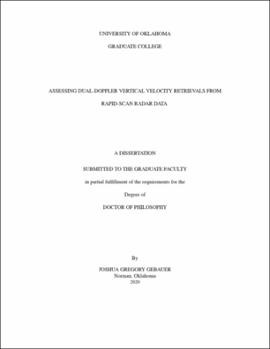| dc.description.abstract | Vertical velocity is the most difficult wind component to accurately retrieve from dual-
Doppler observations. Typical radar scans are conducted with shallow elevation angles and
therefore, the radial velocity observations poorly constrain the vertical velocity in retrievals.
Traditional dual-Doppler analysis (DDA) uses the anelastic mass conservation equation as
a constraint to retrieve vertical velocity. However, procedures that integrate the anelastic
mass conservation equation can have large errors in the vertical velocities due to missing
low-level data, errors in boundary specification, and the compounding of horizontal divergence
errors in the integration. In recent years, it has been proposed to use a vertical
vorticity equation as a weak constraint in addition to the mass conservation equation in order
to improve vertical velocity retrievals. Prior observation simulation experiments have
found that the vorticity equation constraint can improve vertical velocity retrievals in situations
with missing low-level data and radar volume scan times that are sufficiently short to
calculate the vorticity tendency accurately.
In this study, the vertical vorticity equation constraint DDA was tested using real
observations from rapid-scan radars. A dual-Doppler dataset of a convective storm was
collected on 4 Sept 2018 with a maximum volume scan time of 30 seconds. An additional
radar was positioned under the storm and conducted near-vertical planned-position indicator
scans (PPIs), which were used as a verification dataset. In general, the vorticity equation
DDA was able to improve vertical velocity retrievels, but the improvement was dependent
on the time between volume scans and the technique used to calculate the vorticity tendency.
When the time between volume scans was 30 seconds, a simple centered difference
of the vorticity calculated from provisional wind retrievals was sufficient for estimating
the vorticity tendency, but with greater time between volume scans this method resulted
in significantly degraded vertical velocities. A technique that used advection correction to
shorten the time difference in the centered difference improved the vertical velocities of
these longer volume scan times, but caused the DDAs with 30 seconds between volume
scans to become slightly worse. A new three-dimensional advection correction technique
that was developed for the vorticity tendency estimation produced slightly better vertical
velocity retrievals than those that used two-dimensional advection correction. One key
difference between these results and those of the prior OSSE experiments is that the improvement
in the retrieved vertical velocities occurred even though there was not a large
data void between the lowest data level and the ground. Additionally, the vorticity equation
constraint DDA was more forgiving to radar data errors as it did not produce unphysical
vertical velocities in a region of sidelobe contamination that was present in the other DDAs.
Considering that observation errors are a common occurrence in radar datasets, these results
suggest that the vorticity equation constrained DDA could be more beneficial than
what the original OSSE studies indicated.
Another analysis technique that has gained popularity in recent years is ensemble
Kalman filter (EnKF) analysis. Prior OSSEs have suggested that EnKF analyses can be
more accurate than DDAs. Unfortunately, in this study the EnKF analyses were hampered
by catastrophic filter divergence. The adaptive inflation that was used to maintain
ensemble spread due to the large number of radial velocity observations being assimilated
caused large ensemble spread to develop in data sparse regions, which led to extremely
large analysis increments through correlations with regions that had radial velocity observations.
Despite the catastrophic filter divergence, EnKF analyses that used radar observations
that were thinned to 150-s intervals produced vertical velocities that had better
verification statistics than the best DDA. This indicates that if the filter divergence issue is
controlled, EnKF analyses could have more accurate vertical velocities than those obtained
by DDA.
Most importantly, the results shown in this dissertation highlight that rapid-scan
radar data is beneficial to vertical velocity retrievals when that data is paired with a vorticity
equation constrained DDA. This DDA technique and the use of rapid-scan radars should
be prioritized in future observational studies of convective storms. | en_US |
